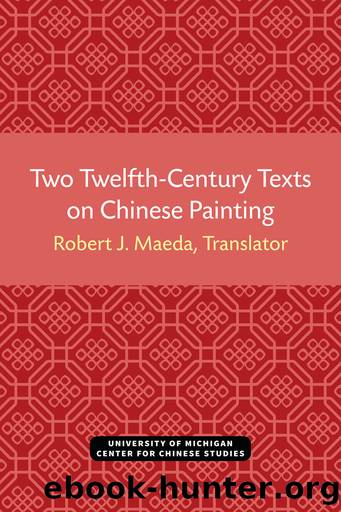Two Twelfth Century Texts on Chinese Painting by Robert J. Maeda

Author:Robert J. Maeda
Language: eng
Format: epub
Publisher: Kenneth G. Lieberthal and Richard H. Rogel Center for Chinese Studies
Published: 2020-01-15T00:00:00+00:00
Notes
1. The Preface sets the high moral tone for the text. While obligatory and heavily dependent on past writers, particularly Chang Yen-yüan, it nonetheless leaves no doubt about the authorâs predilection for landscape painting.
2. Fu Hsi: a legendary emperor said to have had the body of a snake and the head of a man. Chang Yen-yüan is Li-tai ming-hua chi (hereafter referred to as LTMHC), Chapter I, Sect. I, says: âWhen Pâao Hsi [another name for Fu Hsi], made his discovery [a reference to the Dragon-horse with the trigrams on his back] at the shining (Yellow) River, this was the germ of all tablets and books, charts and paintings.â See Wm. R. B. Acker translation in Some Tâang and Pre-Tâang Texts on Chinese Painting (hereafter referred to as Some Tâang), Leiden, 1954, p. 62. Fu Hsi was thought to be a literary and artistic primogenitor which explains his high ranking in both these texts. Further information on Fu Hsi is to be found in ibid., pp. 87â89.
3. Shih Huang and Tsâang Chieh are legendary figures difficult to identify as they are sometimes considered as one person. However, in the present context, they seem to be separated. Acker gives information on them but does not come to any definite conclusion although he considers them as two figures. Ibid., p. 93f.
4. Han Cho is paraphrasing Chang Yen-yüan; see Acker, op. cit., Chapter I, Sect. I, p. 62f.
5. Quoted from Ching Hao: Pi-fa chi. See Shio Sakanishi translation in The Spirit of the Brush (hereafter referred to as Spirit), London, 1948, p. 87, âPainting is delimitation.â The entire paragraph containing the Ching Hao quotation is a paraphrase of a passage in the Preface of Tâang-châao ming-hua lu (herafter referred to as TCMHL) by Chu Ching-hsüan. See A. Soper tr. in Archives of the Chinese Art Society of America, IV, 1950, p. 8.
6. This is quoted from Kuo Jo-hsü, Tâu-hua chien-wen chih (hereafter referred to as THCWC), ch. 5. See Soper translation in Kuo Jo-hsüâs Experiences in Painting (hereafter referred to as Experiences), p. 79. âIn this life I tarry among nonsensical words; In my former body I must have been a master-painter, . . . â The quotation is also to be found in the earlier TCMHL. See Soper tr., Archives, p. 14.
7. Although Han Cho mentions ten chapters there is general agreement that one of these chapters is missing in the text as it now stands. The Shuo-fu edition and the MSTS, IV edition have a âChapter Tenâ titled âLun san ku chih hua kuo yü pu chiâ but its inclusion as part of the original text is disputed. The chapter, as Aoki observes, is of slight interest and adds little to the preceding chapters. Another opinion is expressed by Yü Shao-sung in Shu-hua shu-lu chieh-tâi: âMy opinion is that [the section called] âScenery of the Four Seasonsâ in Chapter 6 was [originally] considered as a separate chapter since the sentences are unconnected [with what precedes] and there is also no connection with the subject of figure painting, etc.
Download
This site does not store any files on its server. We only index and link to content provided by other sites. Please contact the content providers to delete copyright contents if any and email us, we'll remove relevant links or contents immediately.
Papillon by Henry Charrière(793)
Watercolor With Me in the Forest by Dana Fox(589)
The Story of the Scrolls by The Story of the Scrolls; the M(556)
This Is Modern Art by Kevin Coval(456)
A Theory of Narrative Drawing by Simon Grennan(453)
Frida Kahlo by Frida Kahlo & Hayden Herrera(445)
Boris Johnson by Tom Bower(442)
Banksy by Will Ellsworth-Jones(434)
AP Art History by John B. Nici(428)
Van Gogh by Gregory White Smith(425)
Draw More Furries by Jared Hodges(422)
The Art and Science of Drawing by Brent Eviston(421)
Glittering Images: A Journey Through Art From Egypt to Star Wars by Camille Paglia(417)
Scenes From a Revolution by Mark Harris(411)
War Paint by Woodhead Lindy(411)
100 Greatest Country Artists by Hal Leonard Corp(391)
Ecstasy by Eisner.;(386)
Young Rembrandt: A Biography by Onno Blom(371)
Theater by Rene Girard(354)
